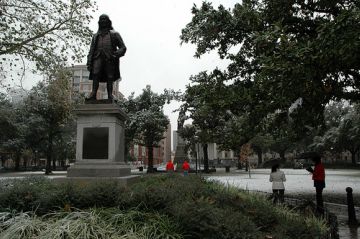
I arrived in New Orleans in December on an auspicious occasion—it was the first snow fall since 2004 and one of only a few that has touched down in this normally warm city in the last forty years. As a Northerner, I felt strangely welcomed to this southern metropolis, and it took me a while to realize that New Orleanians, who aren’t accustomed to snow, seemed confused at first but adapted soon enough.I don’t know what I expected when I arrived in New Orleans but images of Hurricane Katrina were rife in my head as I headed downtown from the airport, thinking I would see signs from that disaster. Little did I know that all the scars of Katrina had all but disappeared from most of the city and what I found was a welcoming place that seemed a fitting venue for Prospect.1.
Judging from the biennial map, the art venues seemed rather evenly sprawled across the city in all directions. A quick orientation at the Hefler Warehouse by a hyperactive tour guide explained that while the tour may appear daunting at first, it isn’t as bad if you concentrated on the 22 main locations (formerly 23) that displayed the work of the primary artists (of which there are 81). For the more adventurous, there were 20 secondary and 71 Art City Site venues, the latter dominated by small commercial galleries showing art by local talents.
After a day of art tourism through the snow and feeling that I had a grasp of how to effectively spend the rest of my four days in New Orleans, I sat down with Dan Cameron, director and curator of Prospect.1, to talk about his vision for this the largest art biennial in North America.
A New York-based curator, Cameron fell in love with New Orleans when he first visited in 1987 and happened upon the city’s renowned Jazz & Heritage Festival. Since that fateful encounter, he hasn’t missed a Jazzfest in 21 years. More recently, Cameron has become the Visual Arts Director of the New Orleans Contemporary Arts Center (CAC), a leading venue for art in the South. As he explained what he set out to do with Prospect.1, the conversation inevitably turned to the topic of this unusual city.
“New Orleans is a big work of art itself,” he explained, “a form of social sculpture.” These were words that resonated with me; in my day-and-a-half in New Orleans, I had already sensed a theatrical air both in the streets and the Prospect.1 venues. I immediately noticed that music was more prevalent in the art venues than other biennials I had ever seen. At CAC, Candice Breitz’s Legend (A Portrait of Bob Marley) consisted of thirty television screens signing Bob Marley’s Buffalo Soldier. The noise resonated throughout the museum. At first it felt nostalgic and familiar, but eventually it started grating on my nerves until I decided it was obnoxious, as it seeped into my experience with at least half a dozen other works. At the Old U.S. Mint, Sanford Biggers’ Blossom (2007) endlessly played Billie Holiday’s Strange Fruit. But this time, the ominous song made you feel like something mysterious lay around every corner and it felt welcome, if somewhat chilling.
Cameron pointed out that while New Orleans may be best known for its cuisine, music, and nightlife, it was a sensual city that appreciated all forms of pleasure, remarking that, “creative expression is central to New Orleans’ identity.” He added that New Orleans sustains its culture through architecture, cuisine and the arts, and Prospect.1 is working to ensure that visual art plays a crucial role in that evolving identity.
During our conversation, I mentioned that walking through the biennial felt like I was endlessly learning about New Orleans as I discovered new work and its context within the city. The content felt fresh and even works that didn’t seem to fit perfectly into the biennial, like Isaac Julien’s Baltimore, were different in this context. Cameron admitted that he included Julien’s work simply to introduce his work to the local scene. Julien’s video work is bold and enigmatic. African-American characters walk into different types of museums and make us wonder about the role of artifact and consciousness raising, particularly in a black cultural context. Three screens project various perspectives and narratives that all seem colored by the 1970s. There is a strain of science fiction in the work that added an air of amazement while making me wonder if the artist was trying to speak more about our cultural future rather than our past.
Cameron was pleased with the way the interaction between artists and venues played out and when I pressed him for details, he cited Navin Rawanchaikul and Tyler Russell’s project as a perfect example of what art could achieve on a local scale. As the result of a typo in an obituary, the multicultural Thai artist learned of the death of local jazz great Narvin Kimball. For their contribution to Prospect.1, Rawanchaikul and Russell organized a traditional New Orleans jazz funeral complete with banners painted in a style reminiscent of Bollywood posters. The funerary march took place during Prospect.1’s opening weekend and the result, according to Cameron, was warmly welcomed by the community, which included jazz musicians, family, friends and fans, all of whom seemed to appreciate Rawanchaikul and Russell’s fresh and sincere approach.
I then asked Cameron how locals were reacting in general to this ambitious art biennial that rivals anything that even New York or Los Angeles could conjure up. “New Orleanians are ready for anything,” he assured me. So, I ventured out to see if that was true.
This post is the first of five on my four days in New Orleans touring the sights and sounds of Prospect.1.